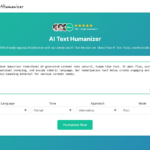The proliferation of AI-driven writing tools has undeniably transformed the landscape of content creation. While these tools offer unprecedented speed and efficiency, they’ve also introduced a critical challenge: discerning between human-authored and AI-generated text. This challenge has spurred the development of AI content detectors, sophisticated technologies designed to analyze and classify text based on its origin. This article provides a comprehensive exploration of AI content detectors, examining their operational principles, the underlying technologies, accuracy considerations, and their role in maintaining digital integrity. We’ll also highlight how tools like AI Text Humanizer can empower you to effectively navigate this evolving domain.
Contents
What You Will Learn
- A detailed explanation of AI content detectors and their operational methodologies
- An in-depth look at the specific techniques and technologies employed in AI-generated text detection
- A balanced assessment of the reliability and limitations of current AI detection tools
- A clear differentiation between AI content detection tools and traditional plagiarism checkers, highlighting their distinct purposes and analytical approaches
What is an AI Content Detector?
At its core, an AI content detector is a software application that evaluates a given text to determine the likelihood of it being generated, either wholly or in part, by artificial intelligence. This evaluation involves a meticulous analysis of various textual attributes, extending beyond simple word matching to encompass deeper linguistic and stylistic characteristics.
Here’s a breakdown of the key elements that AI content detectors scrutinize:
- Linguistic Style: This encompasses word choice, phrasing patterns, and the overall tone of the writing. AI-generated text may tend to have certain stylistic consistencies or peculiarities that differ from human writing.
- Syntactic Structure: This refers to the arrangement of words and phrases within sentences. AI-generated text might display less variation in sentence structure or complexity compared to human writing.
- Semantic Coherence: This involves the logical flow and meaning of the text. AI-generated content may sometimes lack the contextual depth or nuanced understanding that characterizes human writing.
- Statistical Anomalies: This includes unusual frequencies of words or phrases or deviations from typical statistical patterns observed in human language.
To perform this analysis, AI content detectors often rely on a combination of linguistic analysis techniques and comparisons with extensive datasets of both human-written and AI-generated text.
The growing prominence of AI content detectors can be attributed to several factors:
- Ensuring Content Authenticity: In the digital age, where vast amounts of content are produced daily, AI detectors play a vital role in verifying the originality and genuineness of online material.
- Upholding Academic Honesty: Educational institutions utilize these tools to deter and detect plagiarism and other forms of academic misconduct involving the use of AI writing tools.
- Maintaining Professional Standards: Businesses, publishers, and other organizations employ AI detectors to ensure the quality, accuracy, and originality of the content they commission or disseminate.
These applications underscore the crucial role of AI content detectors in preserving the integrity of written communication across various domains.
How Accurate Are AI Content Detectors?
While AI content detectors offer valuable assistance in identifying AI-generated text, it’s essential to acknowledge that their accuracy is not absolute. Several factors contribute to the inherent challenges in achieving perfect accuracy:
- The Nuances of Language: Human language is characterized by its complexity, ambiguity, and constant evolution. AI detectors may struggle to fully capture the subtleties of figurative language, idiomatic expressions, and contextual variations in meaning.
- The Evolving Nature of AI: AI writing tools are continuously being refined, with developers actively working to enhance their ability to mimic human writing styles. This ongoing evolution presents a moving target for AI detectors, requiring them to adapt and update their algorithms to maintain effectiveness.
- The Potential for Errors: AI detectors, like any other technology, are susceptible to errors. They may produce false positives, incorrectly flagging human-written text as AI-generated, or false negatives, failing to detect AI-generated content.
For instance, research studies have demonstrated that AI detectors can sometimes misclassify a notable percentage of human-written articles, highlighting the risk of false positives.
Given these limitations, it’s crucial to adopt a cautious approach when interpreting the results of AI detection tools.
Here are some key recommendations:
- Human Oversight: Always supplement AI detection results with careful human review. A skilled editor or content specialist can bring valuable contextual understanding and critical judgment to the evaluation process.
- Multiple Tools: Consider using multiple AI detection tools to cross-validate results. Different tools may employ different algorithms and analytical techniques, providing a more comprehensive assessment.
- Contextual Awareness: Evaluate the text within its specific context. Factors such as the purpose of the writing, the target audience, and the overall style should be taken into account.
It’s also important to emphasize that while AI writing tools can be valuable assets, over-reliance on them can have detrimental consequences:
- The Spread of Misinformation: The unchecked use of AI to generate content can contribute to the dissemination of inaccurate or misleading information, particularly if the AI-generated text is not thoroughly fact-checked and verified.
- Negative Impact on Search Engine Rankings: Search engines prioritize high-quality, authoritative, and trustworthy content. AI-generated content that lacks depth, originality, or accuracy is unlikely to perform well in search results.
While manual analysis can be time-consuming, it remains an essential component of ensuring content quality and integrity. AI detection tools can significantly streamline this process, but they should be used as aids to human judgment, not replacements for it.
4 Ways AI Content Detection Works
AI content detectors employ a range of techniques to analyze text and identify potential AI involvement. There’s also a new method that’s been introduced recently techniques often draw upon the same underlying technologies that power AI writing tools, such as machine learning (ML) and natural language processing (NLP).
Here are four prominent methods used in AI content detection:
1. Classifiers
A classifier is a machine learning model designed to categorize data into predefined classes. In the context of AI content detection, the primary classes are typically “human-written” and “AI-generated.”
The operation of a classifier involves the following key steps:
- Training: The classifier is trained on a dataset of text samples that have been meticulously labeled as either human-written or AI-generated. During this training phase, the model learns to identify distinctive patterns and features associated with each class.
- Feature Extraction: The classifier extracts relevant features from the text being analyzed. These features may include linguistic characteristics (e.g., word choice, sentence structure), statistical properties (e.g., word frequencies, sentence lengths), and stylistic elements (e.g., tone, complexity).
- Classification: Based on the learned patterns and extracted features, the classifier assigns the text to the class it most closely resembles. This assignment is typically accompanied by a confidence score, indicating the model’s certainty in its prediction.
To illustrate, imagine a classifier trained to distinguish between emails and spam. The model would learn to identify features such as sender information, subject line keywords, and message body content that are characteristic of each category.
Common machine learning algorithms used in classifiers include:
- Decision Trees: These models use a tree-like structure to make decisions based on a series of rules.
- Logistic Regression: This statistical technique predicts the probability of a text belonging to a certain class.
- Random Forest: This algorithm combines multiple decision trees to improve accuracy and robustness.
- Support Vector Machines: These models find the optimal boundary between different classes in a high-dimensional space.
It’s crucial to recognize that classifiers are not infallible. They can be influenced by biases in the training data or may struggle to generalize to text that deviates significantly from the patterns they have learned.
For example, a classifier trained primarily on formal writing may misclassify creative or informal text as AI-generated. To mitigate these issues, classifiers require ongoing updates and refinement to keep pace with the evolving characteristics of both human and AI-generated text.
2. Embeddings
Embeddings provide a way to represent words and phrases as numerical vectors in a high-dimensional space. This vector representation captures the semantic relationships between words, allowing AI models to understand and process language more effectively.
Here’s a breakdown of the core concepts:
- Vector Representation: Each word is mapped to a unique vector, where the values in the vector correspond to different aspects of the word’s meaning and usage.
- Semantic Relationships: Words with similar meanings are located closer to each other in the vector space, reflecting their semantic proximity.
For instance, the vectors for “king” and “queen” would be closer to each other than the vectors for “king” and “table.”
Embeddings play a crucial role in AI content detection by enabling various types of analysis:
- Word Frequency Analysis: This technique examines the distribution of words in the text. AI-generated text may exhibit a higher frequency of common words and lower lexical diversity compared to human writing.
- N-gram Analysis: N-grams are sequences of n consecutive words. Analyzing the frequency and patterns of N-grams can reveal stylistic tendencies and repetitive phrasing that may be indicative of AI generation.
- Syntactic Analysis: This involves analyzing the grammatical structure of sentences. AI-generated text may sometimes lack the syntactic complexity and variation found in human writing.
- Semantic Analysis: This technique delves into the meaning of words and phrases within the context of the text. Human writing often incorporates nuances such as metaphors, idioms, and cultural references, which AI models may struggle to fully comprehend or replicate.
Effective AI content detection often involves a combination of these analyses. However, processing and interpreting high-dimensional embeddings can be computationally intensive and challenging, requiring sophisticated techniques for dimensionality reduction and data visualization. Tools like AI Text Humanizer are equipped to handle these complexities and provide insightful analysis.
3. Perplexity
Perplexity is a metric that measures how well an AI model predicts a given sequence of text. In simpler terms, it quantifies how “surprised” the model is when it encounters new text.
The underlying principle is that AI models are trained on specific datasets, and they tend to be more proficient at predicting text that closely resembles their training data. Human writing, with its inherent creativity and unpredictability, may exhibit higher perplexity compared to AI-generated text, which often adheres to more predictable patterns.
Imagine an AI model trained on a corpus of news articles. If you feed it another news article, it will likely be able to predict the next word with relatively high accuracy, resulting in low perplexity. However, if you feed it a piece of poetry, it may struggle to predict the word choices and sentence structure, leading to higher perplexity.
While perplexity can be a useful indicator, it’s not a foolproof measure of AI-generated content.
Here are some important caveats:
- Nonsense Text: Random or incoherent text will also exhibit high perplexity, even if it’s not human-written.
- Simple Writing: Human writing that is simple, repetitive, or formulaic may have low perplexity and be incorrectly flagged as AI-generated.
Therefore, perplexity is most effective when used in conjunction with other detection methods that consider contextual and stylistic factors.
4. Burstiness
Burstiness is a metric that quantifies the variability in sentence structure within a text. It measures the degree to which sentences differ in terms of length, complexity, and grammatical construction.
AI-generated text often tends to exhibit lower burstiness, characterized by more uniform sentences with less variation. This uniformity can result from AI models’ tendency to rely on common sentence patterns and avoid stylistic experimentation.
Human writing, on the other hand, typically displays higher burstiness, with a mix of short and long sentences, simple and complex structures, and a greater degree of stylistic flair. This variability contributes to the natural rhythm and flow of human language.
For example, consider the following two passages:
- Passage A (Low Burstiness): “The cat sat on the mat. The mat was soft and warm. The cat purred contentedly. It closed its eyes and slept.”
- Passage B (High Burstiness): “Curled upon the soft, warm mat, the cat purred, a low rumble of contentment. Its eyes fluttered closed, and it drifted into a peaceful slumber.”
Passage B exhibits greater burstiness, with more varied sentence lengths and structures, creating a more engaging and natural reading experience.
While burstiness can be a valuable indicator of AI-generated content, it’s not a definitive measure on its own. AI models can be instructed to generate text with more varied sentence structures, potentially circumventing detectors that rely solely on burstiness analysis. A robust AI detector incorporates burstiness as one of several analytical criteria to enhance accuracy.
Key Technologies Behind AI Content Detection
The effectiveness of AI content detection relies heavily on two fundamental technologies:
Machine Learning (ML)
Machine learning empowers AI detectors to learn from data and identify complex patterns that distinguish between human and AI-generated text.
Here are some key applications of ML in AI content detection:
- Pattern Recognition: ML algorithms can analyze large datasets of text to identify subtle linguistic, stylistic, and statistical patterns that are characteristic of either human or AI authorship.
- Predictive Analysis: ML enables AI detectors to predict the likelihood of the next word in a sequence. Low “surprise” or predictability in this analysis can be an indicator of AI-generated text.
Natural Language Processing (NLP)
Natural language processing provides AI detectors with the ability to understand, interpret, and analyze human language.
Here are some key applications of NLP in AI content detection:
- Linguistic Analysis: NLP techniques allow detectors to analyze the grammatical structure, syntax, and semantics of text, enabling them to identify subtle stylistic differences and contextual nuances.
- Semantic Understanding: NLP helps detectors to understand the meaning of words and phrases within the context of the text, enabling them to identify inconsistencies or a lack of depth in AI-generated content.
In addition to ML and NLP, other supporting technologies contribute to AI content detection:
- Data Mining: Techniques for extracting relevant information and patterns from large datasets.
- Text Analysis Algorithms: Algorithms specifically designed to analyze textual features such as vocabulary usage, complexity, and style.
AI Detectors vs. Plagiarism Checkers
While both AI detectors and plagiarism checkers aim to ensure originality in writing, they operate through distinct mechanisms and serve different purposes.
Here’s a comparison:
- AI Detectors: Analyze the intrinsic characteristics of the text itself, such as linguistic patterns, stylistic features, and statistical properties, to identify potential AI involvement.
- Plagiarism Checkers: Compare the text against a database of existing sources to detect instances of direct copying or close similarity.
Think of it this way: An AI detector is like a forensic linguist analyzing a piece of writing to determine its authorship, while a plagiarism checker is like comparing a document to a library of known works to find matching passages.
It’s important to note that while AI writing tools are often trained to avoid direct plagiarism, they can still produce content that lacks originality or depth. This is where AI detectors play a crucial role in ensuring content quality and authenticity.
In this rapidly evolving digital environment, having access to reliable tools for assessing content authenticity is paramount. That’s where platforms come in. Our comprehensive AI content analysis platform empowers you to:
- Accurately Determine AI Involvement: Our advanced algorithms employ a combination of the detection techniques discussed earlier to provide you with a robust and precise evaluation of the likelihood of AI-generated text.
- Maintain Content Integrity: By identifying potential AI-generated content, you can uphold the highest standards of originality, quality, and trustworthiness in your written materials.
- Enhance Efficiency and Productivity: Our automated analysis streamlines the detection process, saving you significant time and effort compared to manual evaluation.
Conclusion
AI content detectors have emerged as essential tools in the digital age, playing a critical role in navigating the complexities of AI-generated content. As AI writing technology continues to advance, the ability to effectively discern between human and machine-authored text will remain crucial for maintaining online trust, preserving content integrity, and upholding the value of human creativity.
While AI detectors are not infallible, they provide invaluable insights and can significantly enhance the content review process. By understanding the underlying mechanisms of these tools and utilizing them responsibly, we can harness the benefits of AI while safeguarding the integrity of written communication.


